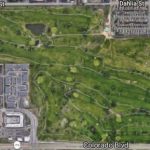The Battle Over the Future of Park Hill Is About More Than a Golf Course
By Sara Fleming Westword December 26,2019

Former mayor Wellington Webb speaks in favor of preserving the conservation easement his administration put on Park Hill Golf Course. Sara Fleming
For the past few months, most of the Westword headlines that focus on the Park Hill neighborhood in northeast Denver have centered on a certain 155-acre stretch of land and a seemingly endless trove of historical and legal questions about it. The battle over the future of Park Hill Golf Course heated up when developer Westside Investments bought it in July, and it’s not likely to settle down for years. Westside is trying to figure out a legal route to remove a conservation easement that currently prohibits development, to the chagrin of a group of residents who would rather see the land remain open space.
But the future of the now-defunct golf course is not the only question facing this historic Denver neighborhood. Park Hill (which is really three statistical neighborhoods as defined by the U.S. Census: northeast, north and south Park Hill) is experiencing rapid gentrification and displacement, especially impacting African-Americans. The debate over the golf course has brought out tensions over what it means for the community to have a voice in its future.
The golf course sits squarely in northeast Park Hill, the historically black part of the neighborhood. So far, Save Open Space (SOS) Denver has been the loudest grassroots group taking a side on the course, opposing any development on the land. But many of its members are not from the immediately proximate neighborhood, leading some northeast Park Hill community leaders to distrust SOS. Imam Abdur-Ahim Ali is the director of the Northeast Denver Islamic Center, a mosque just a block south of the golf course. “For [SOS Denver] to be where they are and to have this much concern kind of raises your eyebrows,” he says.
Park Hill has long presented itself as a beacon of racial harmony — a diverse, integrated and accepting neighborhood, touted as an example for the nation. Martin Luther King Jr. even visited the neighborhood to speak at Montview Boulevard Presbyterian Church in January 1964. Through the community organization Park Hill Action Committee, residents fought “blockbusting” practices (in which real estate developers sought to profit off of “white flight”), seeking instead to become an integrated neighborhood. But Park Hill’s integration was not equal throughout. The southern part of the neighborhood has always been whiter and wealthier than the rest.
Northeast Park Hill, meanwhile, was for decades a middle-class, majority-black neighborhood with a strong community, where children would play on the sloping lawns and black-owned businesses thrived. Constance Ross’s family was one of many black families that began moving farther east in Denver during the ’60s and ’70s after redlining became illegal. The family ended up in northeast Park Hill, in a house across from the golf course. “My brother used to steal over there during the night, jump over the fence, collect all the abandoned golf balls and have them in a bucket, bring them back over, wash all them, polish ’em up, go over there to the parking lot and sell them to the golfers,” she remembers. The northeast Park Hill neighborhood became a primarily middle-class black one, and a great place to live, she says.
The Battle Over the Future of Park Hill Is About More Than a Golf Course
![]()



Comments
The Battle Over the Future of Park Hill Is About More Than a Golf Course — No Comments
HTML tags allowed in your comment: <a href="" title=""> <abbr title=""> <acronym title=""> <b> <blockquote cite=""> <cite> <code> <del datetime=""> <em> <i> <q cite=""> <s> <strike> <strong>